Swire Group Report: Impacts of Currency Fluctuation on Qantas
VerifiedAdded on 2020/03/16
|14
|2699
|30
Report
AI Summary
This report provides an overview of the Swire Group, focusing on the impact of currency fluctuations on Qantas Airways and its potential acquisitions. It begins with a background of the business environment in Australia, highlighting its stability and open market. The report then analyzes how currency fluctuations affect Qantas, considering factors like cost effects, shifts in currency values, and passenger mix. It outlines various approaches used by the company to manage currency risks, including cross-currency swaps, interest rate swaps, and credit risk reduction. The report also discusses the impact of currency fluctuations on potential acquisitions, including exchange complexities and aggregate demand. Furthermore, it explores both external and internal strategies for managing these impacts, such as currency futures and netting. The report concludes by examining the impacts of a sharp fall in currency value, the approaches to hedging and the competition from other companies.
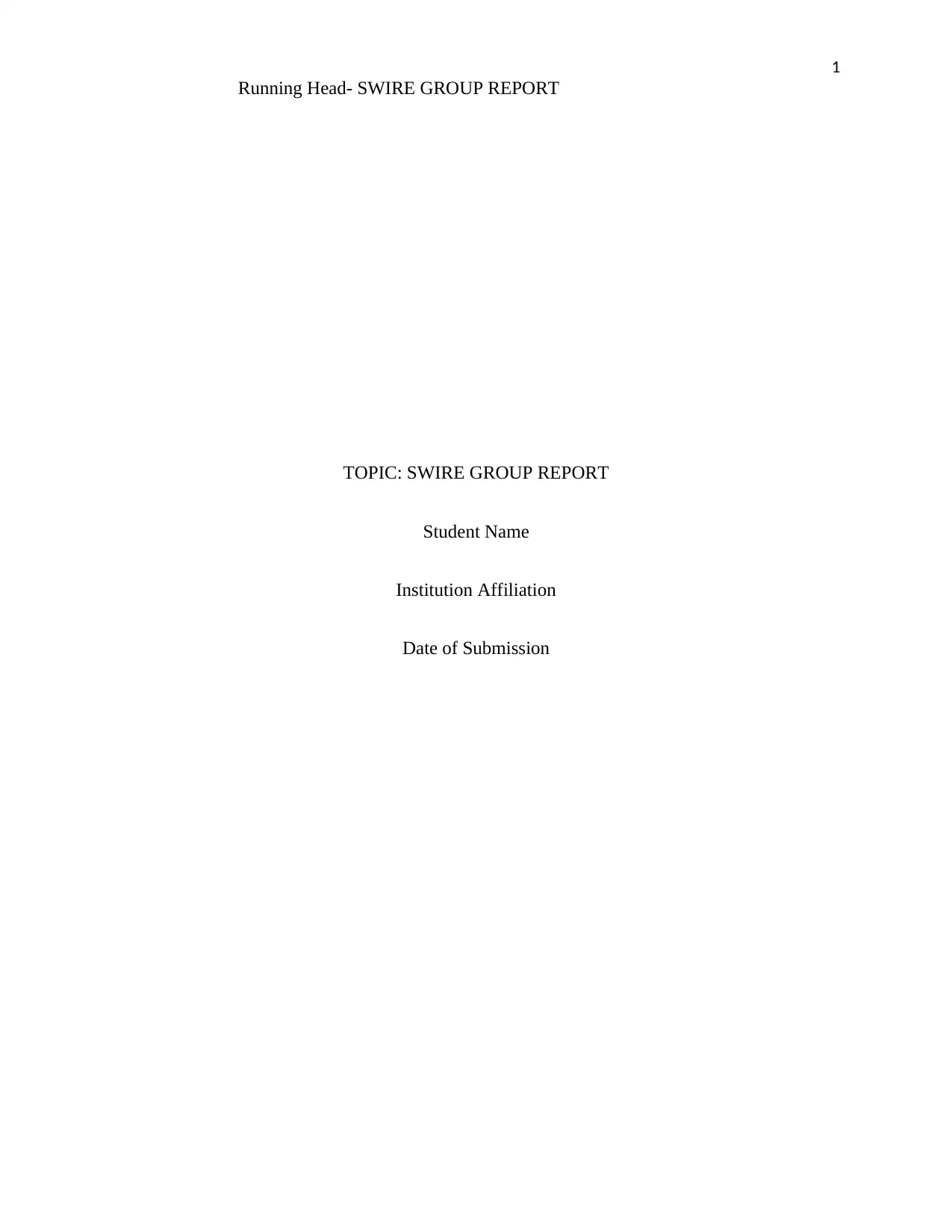
1
Running Head- SWIRE GROUP REPORT
TOPIC: SWIRE GROUP REPORT
Student Name
Institution Affiliation
Date of Submission
Running Head- SWIRE GROUP REPORT
TOPIC: SWIRE GROUP REPORT
Student Name
Institution Affiliation
Date of Submission
Paraphrase This Document
Need a fresh take? Get an instant paraphrase of this document with our AI Paraphraser
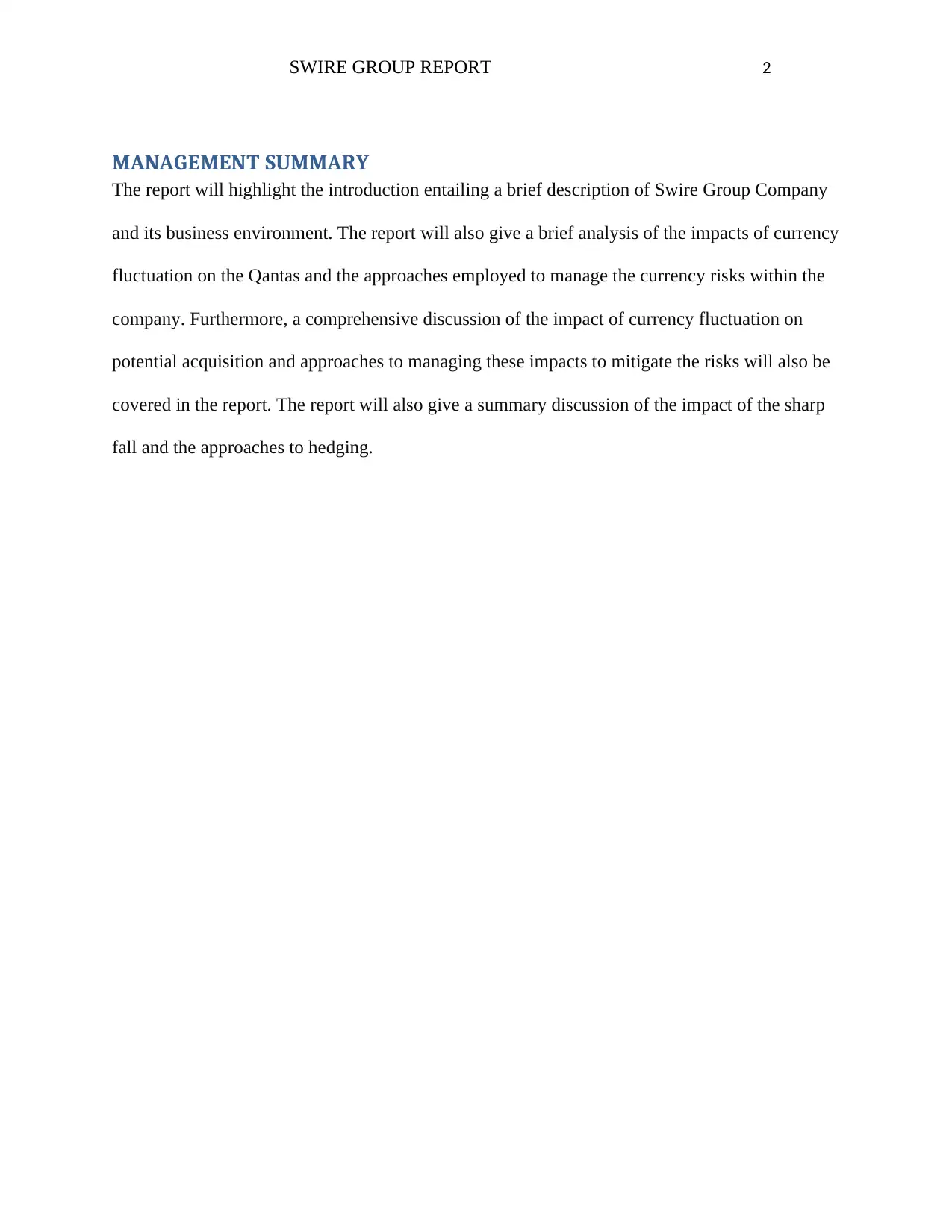
SWIRE GROUP REPORT 2
MANAGEMENT SUMMARY
The report will highlight the introduction entailing a brief description of Swire Group Company
and its business environment. The report will also give a brief analysis of the impacts of currency
fluctuation on the Qantas and the approaches employed to manage the currency risks within the
company. Furthermore, a comprehensive discussion of the impact of currency fluctuation on
potential acquisition and approaches to managing these impacts to mitigate the risks will also be
covered in the report. The report will also give a summary discussion of the impact of the sharp
fall and the approaches to hedging.
MANAGEMENT SUMMARY
The report will highlight the introduction entailing a brief description of Swire Group Company
and its business environment. The report will also give a brief analysis of the impacts of currency
fluctuation on the Qantas and the approaches employed to manage the currency risks within the
company. Furthermore, a comprehensive discussion of the impact of currency fluctuation on
potential acquisition and approaches to managing these impacts to mitigate the risks will also be
covered in the report. The report will also give a summary discussion of the impact of the sharp
fall and the approaches to hedging.
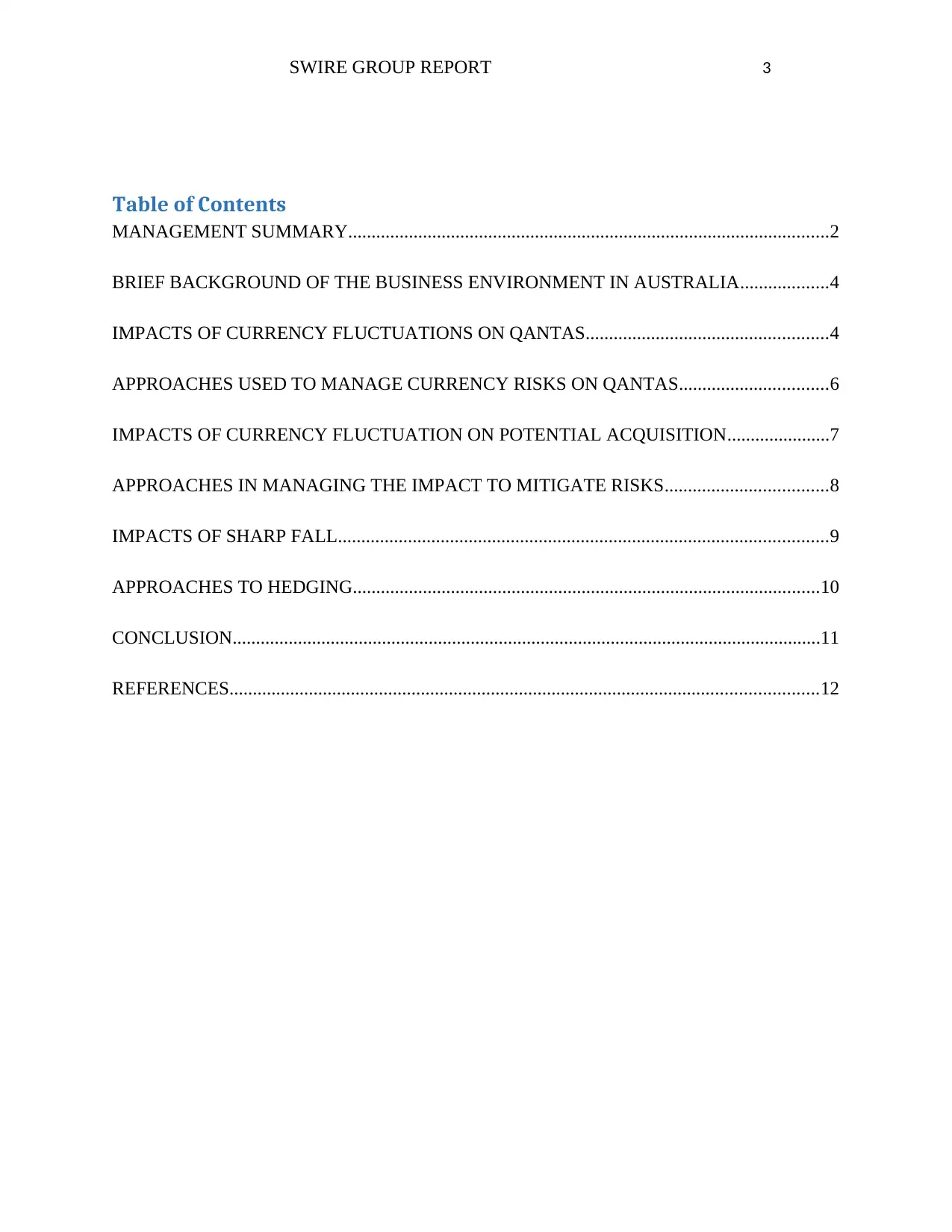
SWIRE GROUP REPORT 3
Table of Contents
MANAGEMENT SUMMARY.......................................................................................................2
BRIEF BACKGROUND OF THE BUSINESS ENVIRONMENT IN AUSTRALIA...................4
IMPACTS OF CURRENCY FLUCTUATIONS ON QANTAS....................................................4
APPROACHES USED TO MANAGE CURRENCY RISKS ON QANTAS................................6
IMPACTS OF CURRENCY FLUCTUATION ON POTENTIAL ACQUISITION......................7
APPROACHES IN MANAGING THE IMPACT TO MITIGATE RISKS...................................8
IMPACTS OF SHARP FALL.........................................................................................................9
APPROACHES TO HEDGING....................................................................................................10
CONCLUSION..............................................................................................................................11
REFERENCES..............................................................................................................................12
Table of Contents
MANAGEMENT SUMMARY.......................................................................................................2
BRIEF BACKGROUND OF THE BUSINESS ENVIRONMENT IN AUSTRALIA...................4
IMPACTS OF CURRENCY FLUCTUATIONS ON QANTAS....................................................4
APPROACHES USED TO MANAGE CURRENCY RISKS ON QANTAS................................6
IMPACTS OF CURRENCY FLUCTUATION ON POTENTIAL ACQUISITION......................7
APPROACHES IN MANAGING THE IMPACT TO MITIGATE RISKS...................................8
IMPACTS OF SHARP FALL.........................................................................................................9
APPROACHES TO HEDGING....................................................................................................10
CONCLUSION..............................................................................................................................11
REFERENCES..............................................................................................................................12
⊘ This is a preview!⊘
Do you want full access?
Subscribe today to unlock all pages.

Trusted by 1+ million students worldwide
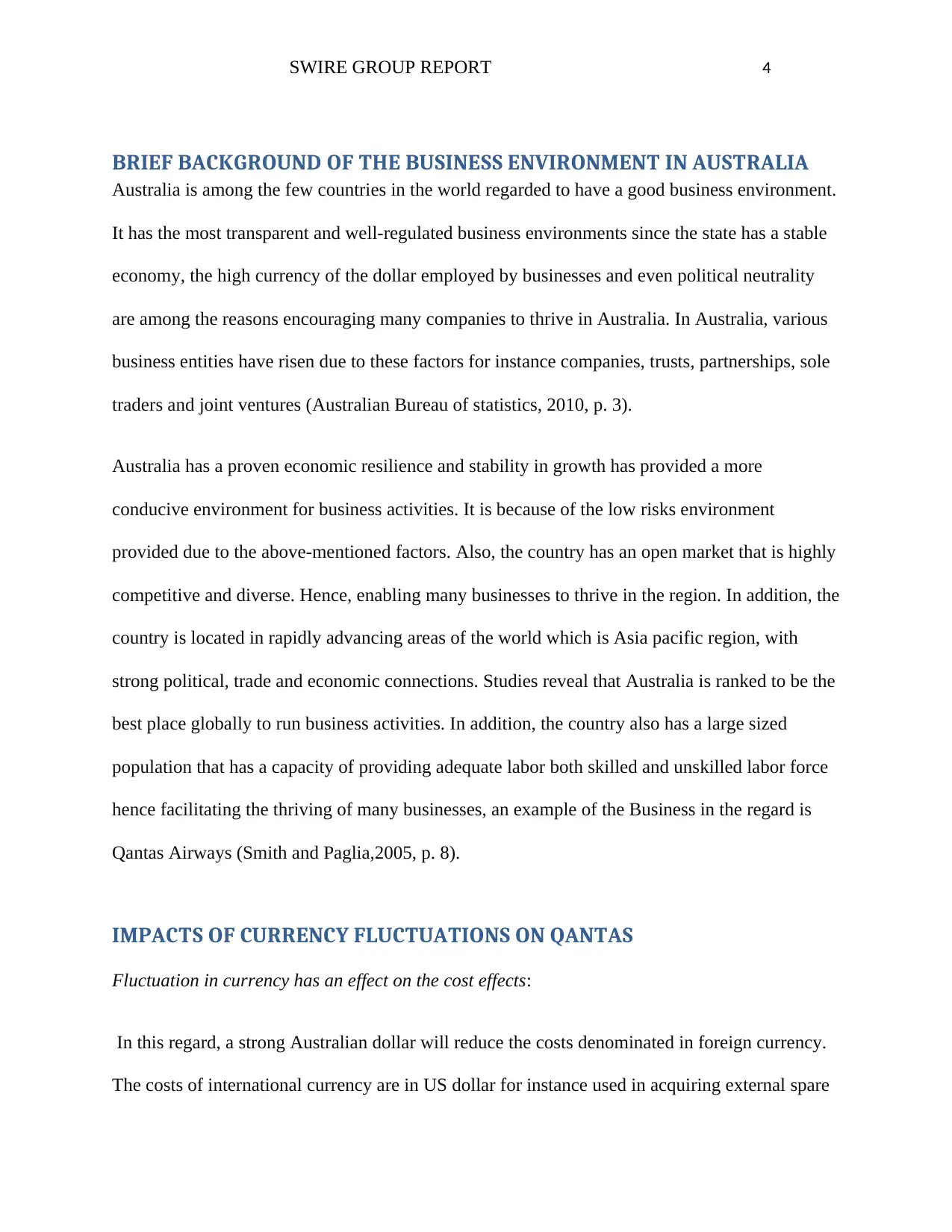
SWIRE GROUP REPORT 4
BRIEF BACKGROUND OF THE BUSINESS ENVIRONMENT IN AUSTRALIA
Australia is among the few countries in the world regarded to have a good business environment.
It has the most transparent and well-regulated business environments since the state has a stable
economy, the high currency of the dollar employed by businesses and even political neutrality
are among the reasons encouraging many companies to thrive in Australia. In Australia, various
business entities have risen due to these factors for instance companies, trusts, partnerships, sole
traders and joint ventures (Australian Bureau of statistics, 2010, p. 3).
Australia has a proven economic resilience and stability in growth has provided a more
conducive environment for business activities. It is because of the low risks environment
provided due to the above-mentioned factors. Also, the country has an open market that is highly
competitive and diverse. Hence, enabling many businesses to thrive in the region. In addition, the
country is located in rapidly advancing areas of the world which is Asia pacific region, with
strong political, trade and economic connections. Studies reveal that Australia is ranked to be the
best place globally to run business activities. In addition, the country also has a large sized
population that has a capacity of providing adequate labor both skilled and unskilled labor force
hence facilitating the thriving of many businesses, an example of the Business in the regard is
Qantas Airways (Smith and Paglia,2005, p. 8).
IMPACTS OF CURRENCY FLUCTUATIONS ON QANTAS
Fluctuation in currency has an effect on the cost effects:
In this regard, a strong Australian dollar will reduce the costs denominated in foreign currency.
The costs of international currency are in US dollar for instance used in acquiring external spare
BRIEF BACKGROUND OF THE BUSINESS ENVIRONMENT IN AUSTRALIA
Australia is among the few countries in the world regarded to have a good business environment.
It has the most transparent and well-regulated business environments since the state has a stable
economy, the high currency of the dollar employed by businesses and even political neutrality
are among the reasons encouraging many companies to thrive in Australia. In Australia, various
business entities have risen due to these factors for instance companies, trusts, partnerships, sole
traders and joint ventures (Australian Bureau of statistics, 2010, p. 3).
Australia has a proven economic resilience and stability in growth has provided a more
conducive environment for business activities. It is because of the low risks environment
provided due to the above-mentioned factors. Also, the country has an open market that is highly
competitive and diverse. Hence, enabling many businesses to thrive in the region. In addition, the
country is located in rapidly advancing areas of the world which is Asia pacific region, with
strong political, trade and economic connections. Studies reveal that Australia is ranked to be the
best place globally to run business activities. In addition, the country also has a large sized
population that has a capacity of providing adequate labor both skilled and unskilled labor force
hence facilitating the thriving of many businesses, an example of the Business in the regard is
Qantas Airways (Smith and Paglia,2005, p. 8).
IMPACTS OF CURRENCY FLUCTUATIONS ON QANTAS
Fluctuation in currency has an effect on the cost effects:
In this regard, a strong Australian dollar will reduce the costs denominated in foreign currency.
The costs of international currency are in US dollar for instance used in acquiring external spare
Paraphrase This Document
Need a fresh take? Get an instant paraphrase of this document with our AI Paraphraser
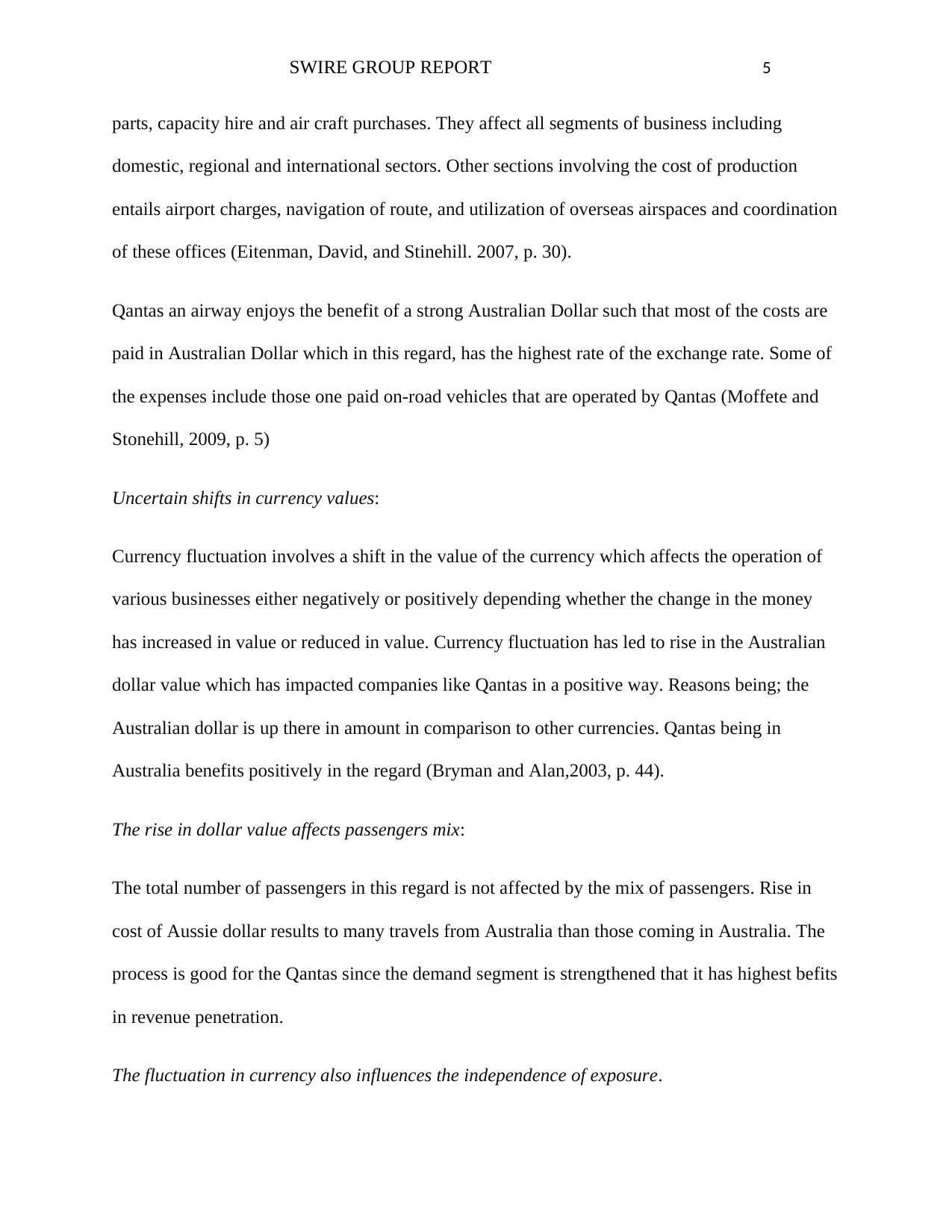
SWIRE GROUP REPORT 5
parts, capacity hire and air craft purchases. They affect all segments of business including
domestic, regional and international sectors. Other sections involving the cost of production
entails airport charges, navigation of route, and utilization of overseas airspaces and coordination
of these offices (Eitenman, David, and Stinehill. 2007, p. 30).
Qantas an airway enjoys the benefit of a strong Australian Dollar such that most of the costs are
paid in Australian Dollar which in this regard, has the highest rate of the exchange rate. Some of
the expenses include those one paid on-road vehicles that are operated by Qantas (Moffete and
Stonehill, 2009, p. 5)
Uncertain shifts in currency values:
Currency fluctuation involves a shift in the value of the currency which affects the operation of
various businesses either negatively or positively depending whether the change in the money
has increased in value or reduced in value. Currency fluctuation has led to rise in the Australian
dollar value which has impacted companies like Qantas in a positive way. Reasons being; the
Australian dollar is up there in amount in comparison to other currencies. Qantas being in
Australia benefits positively in the regard (Bryman and Alan,2003, p. 44).
The rise in dollar value affects passengers mix:
The total number of passengers in this regard is not affected by the mix of passengers. Rise in
cost of Aussie dollar results to many travels from Australia than those coming in Australia. The
process is good for the Qantas since the demand segment is strengthened that it has highest befits
in revenue penetration.
The fluctuation in currency also influences the independence of exposure.
parts, capacity hire and air craft purchases. They affect all segments of business including
domestic, regional and international sectors. Other sections involving the cost of production
entails airport charges, navigation of route, and utilization of overseas airspaces and coordination
of these offices (Eitenman, David, and Stinehill. 2007, p. 30).
Qantas an airway enjoys the benefit of a strong Australian Dollar such that most of the costs are
paid in Australian Dollar which in this regard, has the highest rate of the exchange rate. Some of
the expenses include those one paid on-road vehicles that are operated by Qantas (Moffete and
Stonehill, 2009, p. 5)
Uncertain shifts in currency values:
Currency fluctuation involves a shift in the value of the currency which affects the operation of
various businesses either negatively or positively depending whether the change in the money
has increased in value or reduced in value. Currency fluctuation has led to rise in the Australian
dollar value which has impacted companies like Qantas in a positive way. Reasons being; the
Australian dollar is up there in amount in comparison to other currencies. Qantas being in
Australia benefits positively in the regard (Bryman and Alan,2003, p. 44).
The rise in dollar value affects passengers mix:
The total number of passengers in this regard is not affected by the mix of passengers. Rise in
cost of Aussie dollar results to many travels from Australia than those coming in Australia. The
process is good for the Qantas since the demand segment is strengthened that it has highest befits
in revenue penetration.
The fluctuation in currency also influences the independence of exposure.
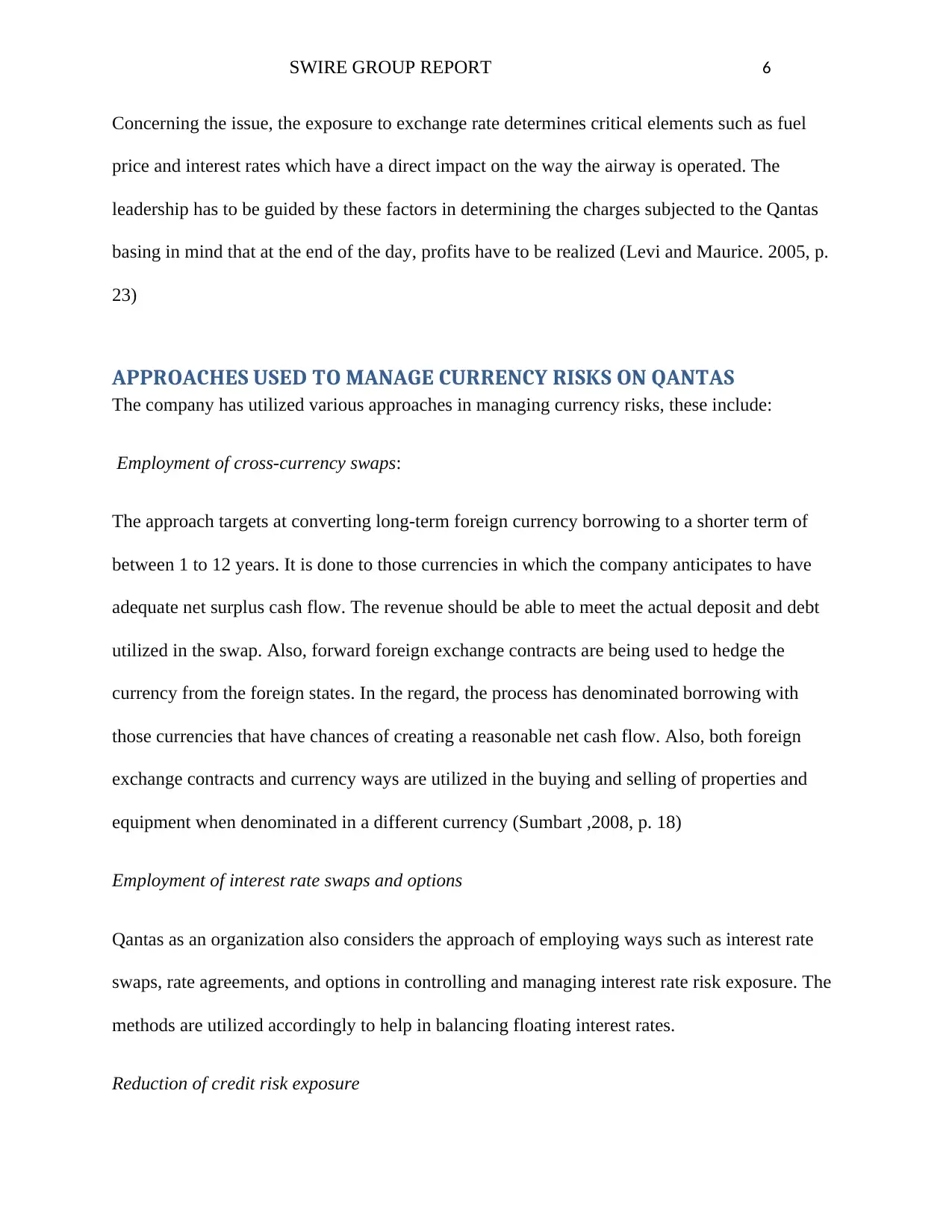
SWIRE GROUP REPORT 6
Concerning the issue, the exposure to exchange rate determines critical elements such as fuel
price and interest rates which have a direct impact on the way the airway is operated. The
leadership has to be guided by these factors in determining the charges subjected to the Qantas
basing in mind that at the end of the day, profits have to be realized (Levi and Maurice. 2005, p.
23)
APPROACHES USED TO MANAGE CURRENCY RISKS ON QANTAS
The company has utilized various approaches in managing currency risks, these include:
Employment of cross-currency swaps:
The approach targets at converting long-term foreign currency borrowing to a shorter term of
between 1 to 12 years. It is done to those currencies in which the company anticipates to have
adequate net surplus cash flow. The revenue should be able to meet the actual deposit and debt
utilized in the swap. Also, forward foreign exchange contracts are being used to hedge the
currency from the foreign states. In the regard, the process has denominated borrowing with
those currencies that have chances of creating a reasonable net cash flow. Also, both foreign
exchange contracts and currency ways are utilized in the buying and selling of properties and
equipment when denominated in a different currency (Sumbart ,2008, p. 18)
Employment of interest rate swaps and options
Qantas as an organization also considers the approach of employing ways such as interest rate
swaps, rate agreements, and options in controlling and managing interest rate risk exposure. The
methods are utilized accordingly to help in balancing floating interest rates.
Reduction of credit risk exposure
Concerning the issue, the exposure to exchange rate determines critical elements such as fuel
price and interest rates which have a direct impact on the way the airway is operated. The
leadership has to be guided by these factors in determining the charges subjected to the Qantas
basing in mind that at the end of the day, profits have to be realized (Levi and Maurice. 2005, p.
23)
APPROACHES USED TO MANAGE CURRENCY RISKS ON QANTAS
The company has utilized various approaches in managing currency risks, these include:
Employment of cross-currency swaps:
The approach targets at converting long-term foreign currency borrowing to a shorter term of
between 1 to 12 years. It is done to those currencies in which the company anticipates to have
adequate net surplus cash flow. The revenue should be able to meet the actual deposit and debt
utilized in the swap. Also, forward foreign exchange contracts are being used to hedge the
currency from the foreign states. In the regard, the process has denominated borrowing with
those currencies that have chances of creating a reasonable net cash flow. Also, both foreign
exchange contracts and currency ways are utilized in the buying and selling of properties and
equipment when denominated in a different currency (Sumbart ,2008, p. 18)
Employment of interest rate swaps and options
Qantas as an organization also considers the approach of employing ways such as interest rate
swaps, rate agreements, and options in controlling and managing interest rate risk exposure. The
methods are utilized accordingly to help in balancing floating interest rates.
Reduction of credit risk exposure
⊘ This is a preview!⊘
Do you want full access?
Subscribe today to unlock all pages.

Trusted by 1+ million students worldwide
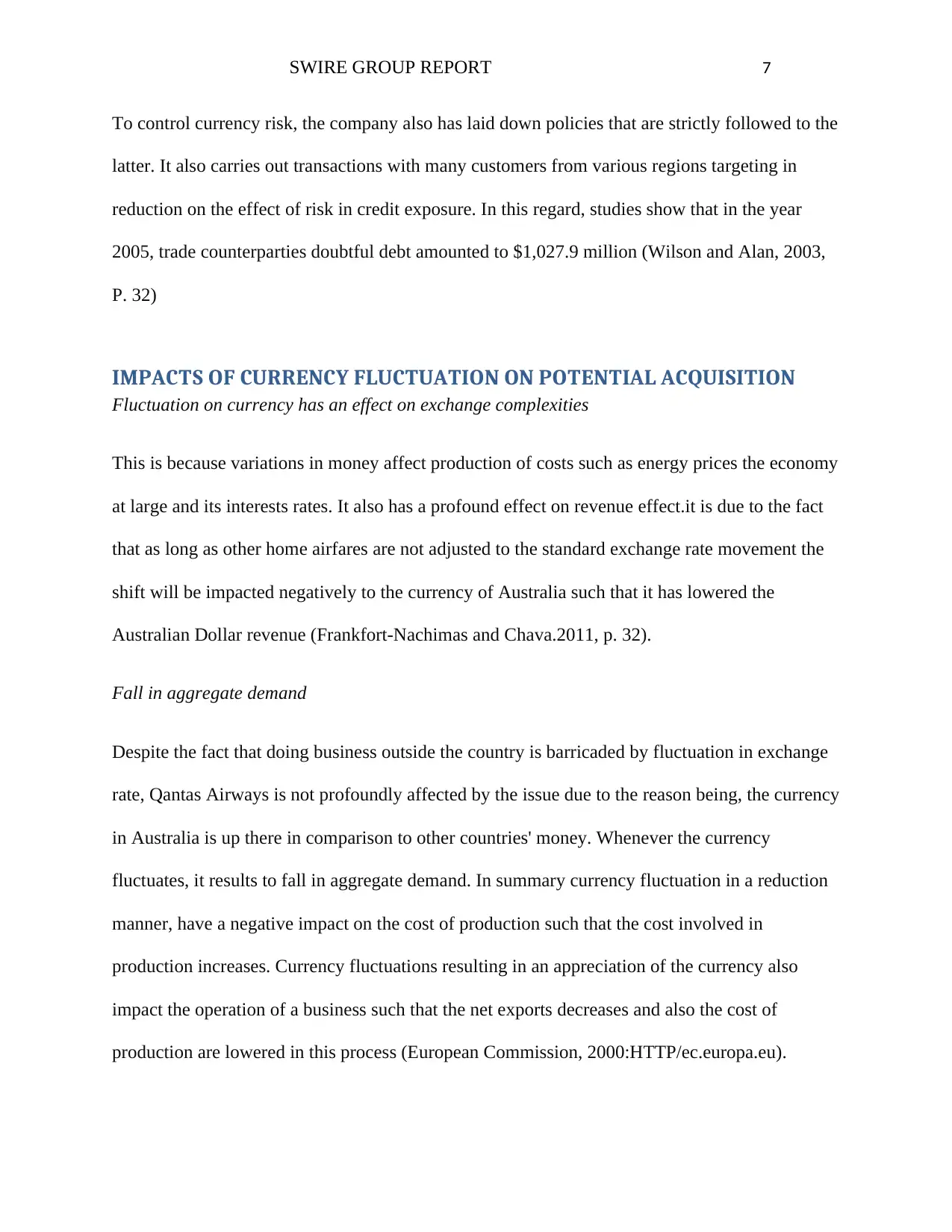
SWIRE GROUP REPORT 7
To control currency risk, the company also has laid down policies that are strictly followed to the
latter. It also carries out transactions with many customers from various regions targeting in
reduction on the effect of risk in credit exposure. In this regard, studies show that in the year
2005, trade counterparties doubtful debt amounted to $1,027.9 million (Wilson and Alan, 2003,
P. 32)
IMPACTS OF CURRENCY FLUCTUATION ON POTENTIAL ACQUISITION
Fluctuation on currency has an effect on exchange complexities
This is because variations in money affect production of costs such as energy prices the economy
at large and its interests rates. It also has a profound effect on revenue effect.it is due to the fact
that as long as other home airfares are not adjusted to the standard exchange rate movement the
shift will be impacted negatively to the currency of Australia such that it has lowered the
Australian Dollar revenue (Frankfort-Nachimas and Chava.2011, p. 32).
Fall in aggregate demand
Despite the fact that doing business outside the country is barricaded by fluctuation in exchange
rate, Qantas Airways is not profoundly affected by the issue due to the reason being, the currency
in Australia is up there in comparison to other countries' money. Whenever the currency
fluctuates, it results to fall in aggregate demand. In summary currency fluctuation in a reduction
manner, have a negative impact on the cost of production such that the cost involved in
production increases. Currency fluctuations resulting in an appreciation of the currency also
impact the operation of a business such that the net exports decreases and also the cost of
production are lowered in this process (European Commission, 2000:HTTP/ec.europa.eu).
To control currency risk, the company also has laid down policies that are strictly followed to the
latter. It also carries out transactions with many customers from various regions targeting in
reduction on the effect of risk in credit exposure. In this regard, studies show that in the year
2005, trade counterparties doubtful debt amounted to $1,027.9 million (Wilson and Alan, 2003,
P. 32)
IMPACTS OF CURRENCY FLUCTUATION ON POTENTIAL ACQUISITION
Fluctuation on currency has an effect on exchange complexities
This is because variations in money affect production of costs such as energy prices the economy
at large and its interests rates. It also has a profound effect on revenue effect.it is due to the fact
that as long as other home airfares are not adjusted to the standard exchange rate movement the
shift will be impacted negatively to the currency of Australia such that it has lowered the
Australian Dollar revenue (Frankfort-Nachimas and Chava.2011, p. 32).
Fall in aggregate demand
Despite the fact that doing business outside the country is barricaded by fluctuation in exchange
rate, Qantas Airways is not profoundly affected by the issue due to the reason being, the currency
in Australia is up there in comparison to other countries' money. Whenever the currency
fluctuates, it results to fall in aggregate demand. In summary currency fluctuation in a reduction
manner, have a negative impact on the cost of production such that the cost involved in
production increases. Currency fluctuations resulting in an appreciation of the currency also
impact the operation of a business such that the net exports decreases and also the cost of
production are lowered in this process (European Commission, 2000:HTTP/ec.europa.eu).
Paraphrase This Document
Need a fresh take? Get an instant paraphrase of this document with our AI Paraphraser
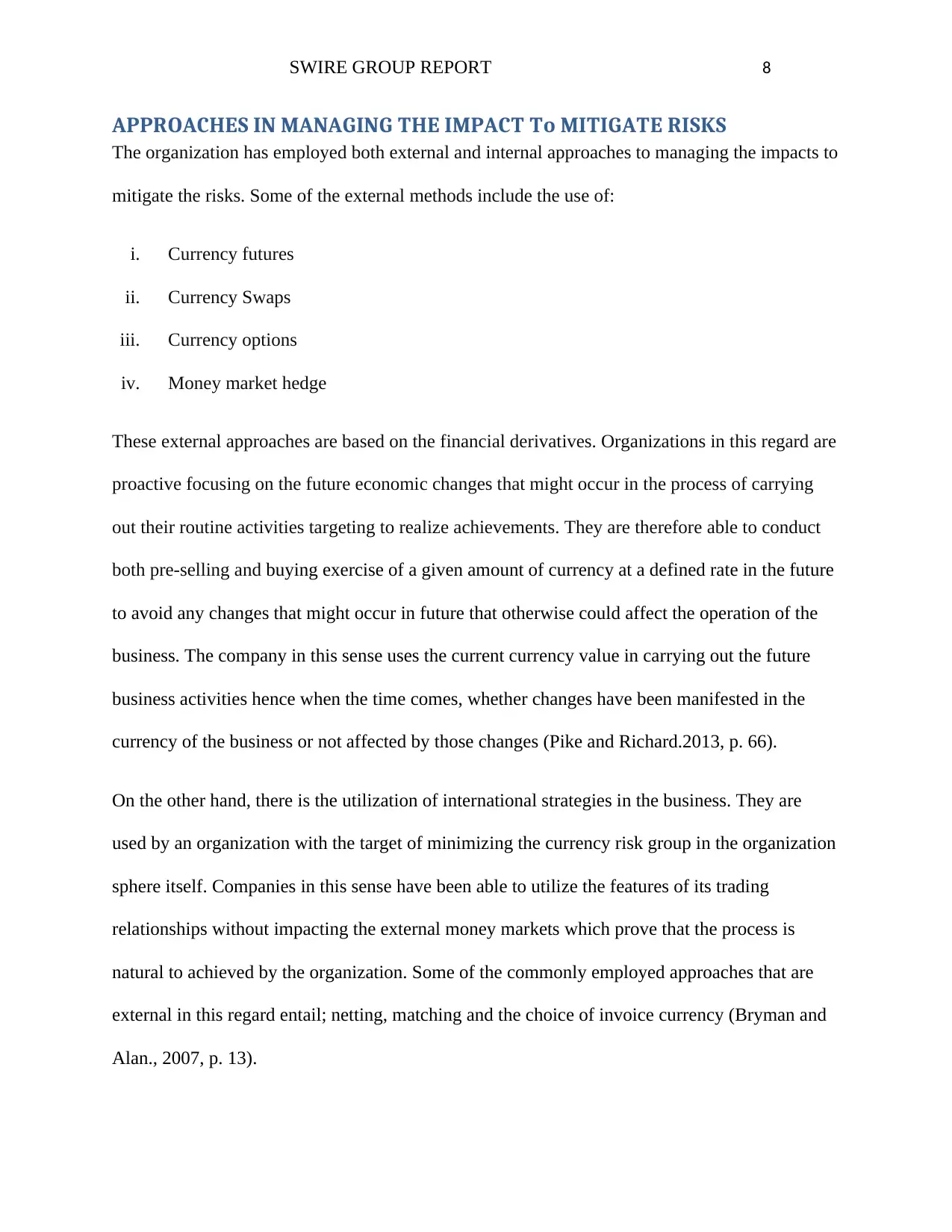
SWIRE GROUP REPORT 8
APPROACHES IN MANAGING THE IMPACT To MITIGATE RISKS
The organization has employed both external and internal approaches to managing the impacts to
mitigate the risks. Some of the external methods include the use of:
i. Currency futures
ii. Currency Swaps
iii. Currency options
iv. Money market hedge
These external approaches are based on the financial derivatives. Organizations in this regard are
proactive focusing on the future economic changes that might occur in the process of carrying
out their routine activities targeting to realize achievements. They are therefore able to conduct
both pre-selling and buying exercise of a given amount of currency at a defined rate in the future
to avoid any changes that might occur in future that otherwise could affect the operation of the
business. The company in this sense uses the current currency value in carrying out the future
business activities hence when the time comes, whether changes have been manifested in the
currency of the business or not affected by those changes (Pike and Richard.2013, p. 66).
On the other hand, there is the utilization of international strategies in the business. They are
used by an organization with the target of minimizing the currency risk group in the organization
sphere itself. Companies in this sense have been able to utilize the features of its trading
relationships without impacting the external money markets which prove that the process is
natural to achieved by the organization. Some of the commonly employed approaches that are
external in this regard entail; netting, matching and the choice of invoice currency (Bryman and
Alan., 2007, p. 13).
APPROACHES IN MANAGING THE IMPACT To MITIGATE RISKS
The organization has employed both external and internal approaches to managing the impacts to
mitigate the risks. Some of the external methods include the use of:
i. Currency futures
ii. Currency Swaps
iii. Currency options
iv. Money market hedge
These external approaches are based on the financial derivatives. Organizations in this regard are
proactive focusing on the future economic changes that might occur in the process of carrying
out their routine activities targeting to realize achievements. They are therefore able to conduct
both pre-selling and buying exercise of a given amount of currency at a defined rate in the future
to avoid any changes that might occur in future that otherwise could affect the operation of the
business. The company in this sense uses the current currency value in carrying out the future
business activities hence when the time comes, whether changes have been manifested in the
currency of the business or not affected by those changes (Pike and Richard.2013, p. 66).
On the other hand, there is the utilization of international strategies in the business. They are
used by an organization with the target of minimizing the currency risk group in the organization
sphere itself. Companies in this sense have been able to utilize the features of its trading
relationships without impacting the external money markets which prove that the process is
natural to achieved by the organization. Some of the commonly employed approaches that are
external in this regard entail; netting, matching and the choice of invoice currency (Bryman and
Alan., 2007, p. 13).
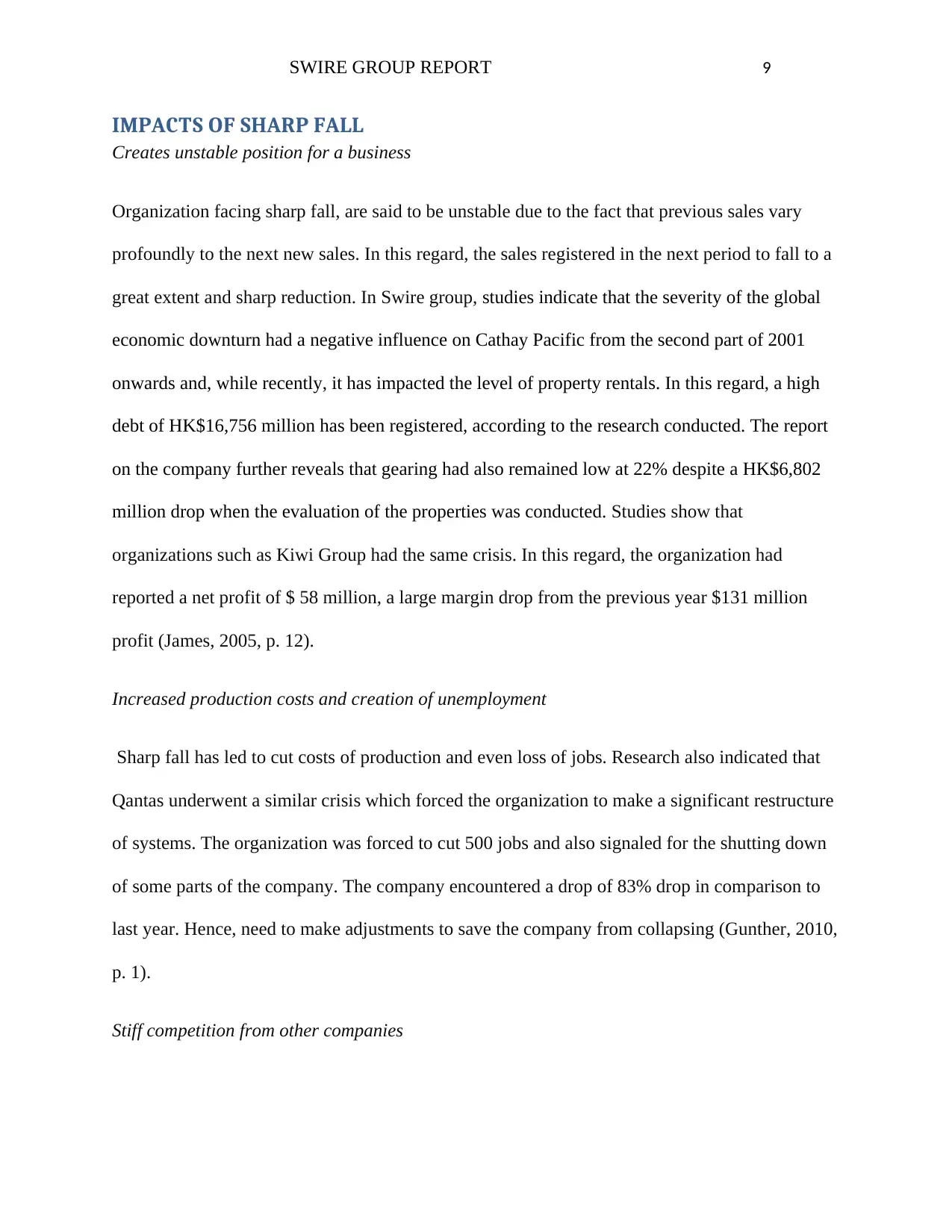
SWIRE GROUP REPORT 9
IMPACTS OF SHARP FALL
Creates unstable position for a business
Organization facing sharp fall, are said to be unstable due to the fact that previous sales vary
profoundly to the next new sales. In this regard, the sales registered in the next period to fall to a
great extent and sharp reduction. In Swire group, studies indicate that the severity of the global
economic downturn had a negative influence on Cathay Pacific from the second part of 2001
onwards and, while recently, it has impacted the level of property rentals. In this regard, a high
debt of HK$16,756 million has been registered, according to the research conducted. The report
on the company further reveals that gearing had also remained low at 22% despite a HK$6,802
million drop when the evaluation of the properties was conducted. Studies show that
organizations such as Kiwi Group had the same crisis. In this regard, the organization had
reported a net profit of $ 58 million, a large margin drop from the previous year $131 million
profit (James, 2005, p. 12).
Increased production costs and creation of unemployment
Sharp fall has led to cut costs of production and even loss of jobs. Research also indicated that
Qantas underwent a similar crisis which forced the organization to make a significant restructure
of systems. The organization was forced to cut 500 jobs and also signaled for the shutting down
of some parts of the company. The company encountered a drop of 83% drop in comparison to
last year. Hence, need to make adjustments to save the company from collapsing (Gunther, 2010,
p. 1).
Stiff competition from other companies
IMPACTS OF SHARP FALL
Creates unstable position for a business
Organization facing sharp fall, are said to be unstable due to the fact that previous sales vary
profoundly to the next new sales. In this regard, the sales registered in the next period to fall to a
great extent and sharp reduction. In Swire group, studies indicate that the severity of the global
economic downturn had a negative influence on Cathay Pacific from the second part of 2001
onwards and, while recently, it has impacted the level of property rentals. In this regard, a high
debt of HK$16,756 million has been registered, according to the research conducted. The report
on the company further reveals that gearing had also remained low at 22% despite a HK$6,802
million drop when the evaluation of the properties was conducted. Studies show that
organizations such as Kiwi Group had the same crisis. In this regard, the organization had
reported a net profit of $ 58 million, a large margin drop from the previous year $131 million
profit (James, 2005, p. 12).
Increased production costs and creation of unemployment
Sharp fall has led to cut costs of production and even loss of jobs. Research also indicated that
Qantas underwent a similar crisis which forced the organization to make a significant restructure
of systems. The organization was forced to cut 500 jobs and also signaled for the shutting down
of some parts of the company. The company encountered a drop of 83% drop in comparison to
last year. Hence, need to make adjustments to save the company from collapsing (Gunther, 2010,
p. 1).
Stiff competition from other companies
⊘ This is a preview!⊘
Do you want full access?
Subscribe today to unlock all pages.

Trusted by 1+ million students worldwide
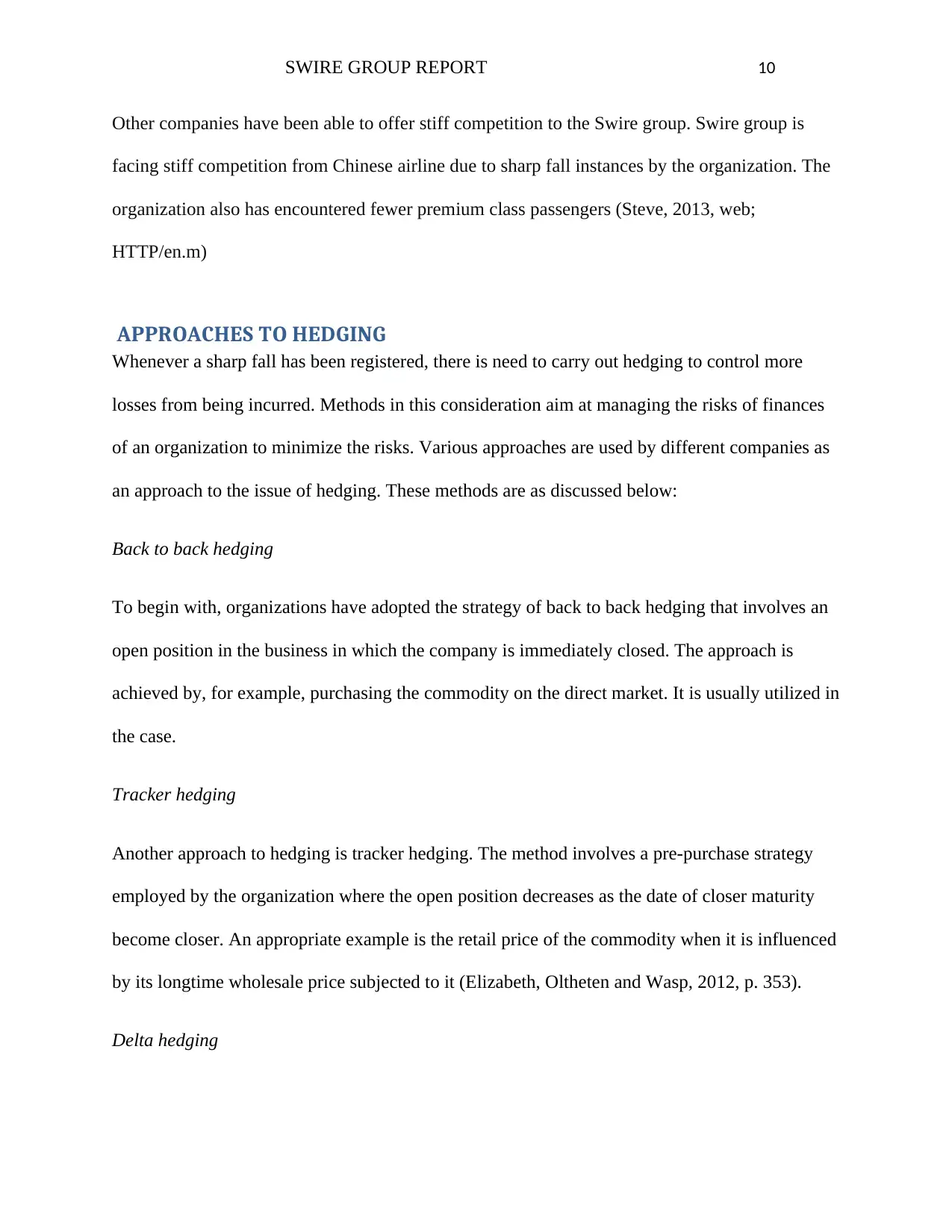
SWIRE GROUP REPORT 10
Other companies have been able to offer stiff competition to the Swire group. Swire group is
facing stiff competition from Chinese airline due to sharp fall instances by the organization. The
organization also has encountered fewer premium class passengers (Steve, 2013, web;
HTTP/en.m)
APPROACHES TO HEDGING
Whenever a sharp fall has been registered, there is need to carry out hedging to control more
losses from being incurred. Methods in this consideration aim at managing the risks of finances
of an organization to minimize the risks. Various approaches are used by different companies as
an approach to the issue of hedging. These methods are as discussed below:
Back to back hedging
To begin with, organizations have adopted the strategy of back to back hedging that involves an
open position in the business in which the company is immediately closed. The approach is
achieved by, for example, purchasing the commodity on the direct market. It is usually utilized in
the case.
Tracker hedging
Another approach to hedging is tracker hedging. The method involves a pre-purchase strategy
employed by the organization where the open position decreases as the date of closer maturity
become closer. An appropriate example is the retail price of the commodity when it is influenced
by its longtime wholesale price subjected to it (Elizabeth, Oltheten and Wasp, 2012, p. 353).
Delta hedging
Other companies have been able to offer stiff competition to the Swire group. Swire group is
facing stiff competition from Chinese airline due to sharp fall instances by the organization. The
organization also has encountered fewer premium class passengers (Steve, 2013, web;
HTTP/en.m)
APPROACHES TO HEDGING
Whenever a sharp fall has been registered, there is need to carry out hedging to control more
losses from being incurred. Methods in this consideration aim at managing the risks of finances
of an organization to minimize the risks. Various approaches are used by different companies as
an approach to the issue of hedging. These methods are as discussed below:
Back to back hedging
To begin with, organizations have adopted the strategy of back to back hedging that involves an
open position in the business in which the company is immediately closed. The approach is
achieved by, for example, purchasing the commodity on the direct market. It is usually utilized in
the case.
Tracker hedging
Another approach to hedging is tracker hedging. The method involves a pre-purchase strategy
employed by the organization where the open position decreases as the date of closer maturity
become closer. An appropriate example is the retail price of the commodity when it is influenced
by its longtime wholesale price subjected to it (Elizabeth, Oltheten and Wasp, 2012, p. 353).
Delta hedging
Paraphrase This Document
Need a fresh take? Get an instant paraphrase of this document with our AI Paraphraser
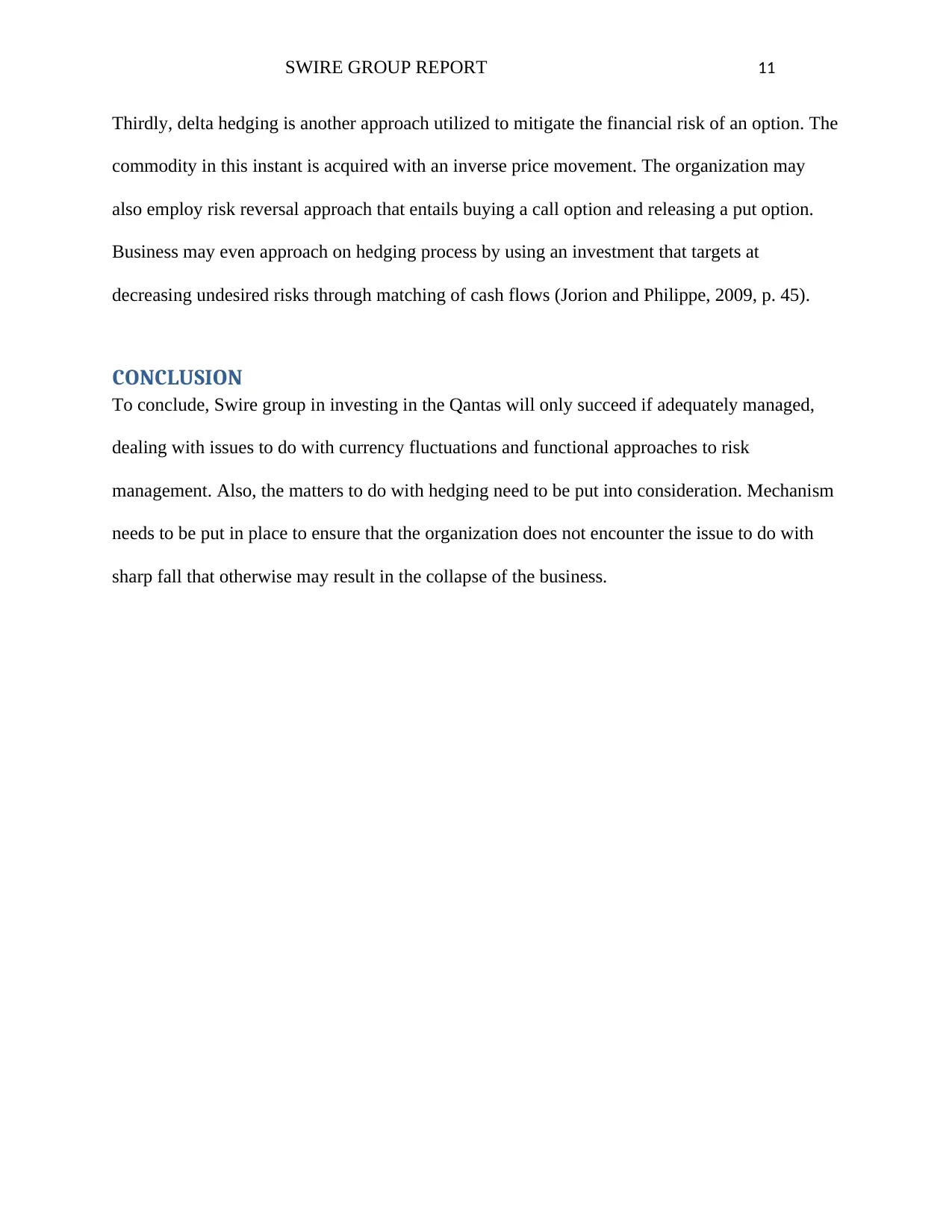
SWIRE GROUP REPORT 11
Thirdly, delta hedging is another approach utilized to mitigate the financial risk of an option. The
commodity in this instant is acquired with an inverse price movement. The organization may
also employ risk reversal approach that entails buying a call option and releasing a put option.
Business may even approach on hedging process by using an investment that targets at
decreasing undesired risks through matching of cash flows (Jorion and Philippe, 2009, p. 45).
CONCLUSION
To conclude, Swire group in investing in the Qantas will only succeed if adequately managed,
dealing with issues to do with currency fluctuations and functional approaches to risk
management. Also, the matters to do with hedging need to be put into consideration. Mechanism
needs to be put in place to ensure that the organization does not encounter the issue to do with
sharp fall that otherwise may result in the collapse of the business.
Thirdly, delta hedging is another approach utilized to mitigate the financial risk of an option. The
commodity in this instant is acquired with an inverse price movement. The organization may
also employ risk reversal approach that entails buying a call option and releasing a put option.
Business may even approach on hedging process by using an investment that targets at
decreasing undesired risks through matching of cash flows (Jorion and Philippe, 2009, p. 45).
CONCLUSION
To conclude, Swire group in investing in the Qantas will only succeed if adequately managed,
dealing with issues to do with currency fluctuations and functional approaches to risk
management. Also, the matters to do with hedging need to be put into consideration. Mechanism
needs to be put in place to ensure that the organization does not encounter the issue to do with
sharp fall that otherwise may result in the collapse of the business.
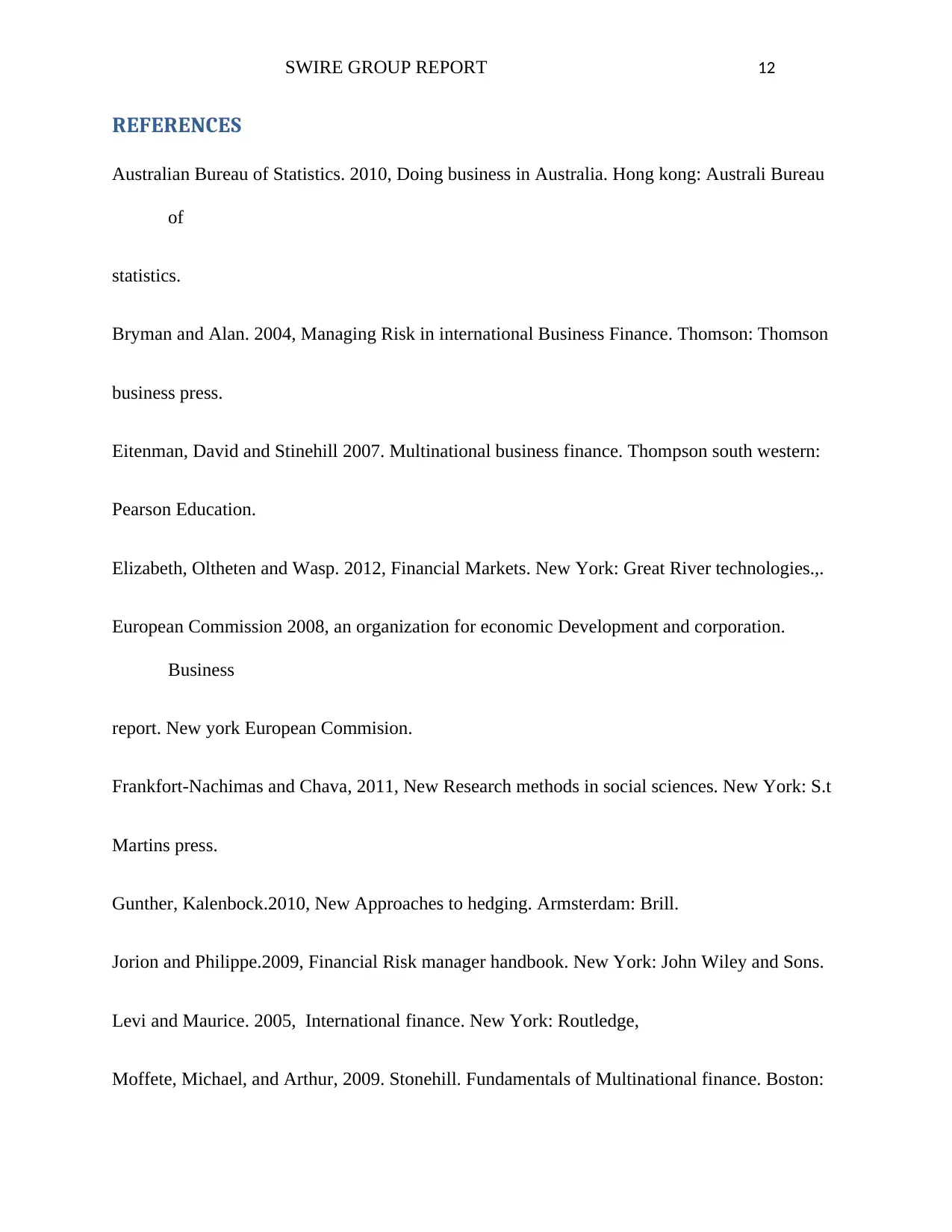
SWIRE GROUP REPORT 12
REFERENCES
Australian Bureau of Statistics. 2010, Doing business in Australia. Hong kong: Australi Bureau
of
statistics.
Bryman and Alan. 2004, Managing Risk in international Business Finance. Thomson: Thomson
business press.
Eitenman, David and Stinehill 2007. Multinational business finance. Thompson south western:
Pearson Education.
Elizabeth, Oltheten and Wasp. 2012, Financial Markets. New York: Great River technologies.,.
European Commission 2008, an organization for economic Development and corporation.
Business
report. New york European Commision.
Frankfort-Nachimas and Chava, 2011, New Research methods in social sciences. New York: S.t
Martins press.
Gunther, Kalenbock.2010, New Approaches to hedging. Armsterdam: Brill.
Jorion and Philippe.2009, Financial Risk manager handbook. New York: John Wiley and Sons.
Levi and Maurice. 2005, International finance. New York: Routledge,
Moffete, Michael, and Arthur, 2009. Stonehill. Fundamentals of Multinational finance. Boston:
REFERENCES
Australian Bureau of Statistics. 2010, Doing business in Australia. Hong kong: Australi Bureau
of
statistics.
Bryman and Alan. 2004, Managing Risk in international Business Finance. Thomson: Thomson
business press.
Eitenman, David and Stinehill 2007. Multinational business finance. Thompson south western:
Pearson Education.
Elizabeth, Oltheten and Wasp. 2012, Financial Markets. New York: Great River technologies.,.
European Commission 2008, an organization for economic Development and corporation.
Business
report. New york European Commision.
Frankfort-Nachimas and Chava, 2011, New Research methods in social sciences. New York: S.t
Martins press.
Gunther, Kalenbock.2010, New Approaches to hedging. Armsterdam: Brill.
Jorion and Philippe.2009, Financial Risk manager handbook. New York: John Wiley and Sons.
Levi and Maurice. 2005, International finance. New York: Routledge,
Moffete, Michael, and Arthur, 2009. Stonehill. Fundamentals of Multinational finance. Boston:
⊘ This is a preview!⊘
Do you want full access?
Subscribe today to unlock all pages.

Trusted by 1+ million students worldwide
1 out of 14
Related Documents
Your All-in-One AI-Powered Toolkit for Academic Success.
+13062052269
info@desklib.com
Available 24*7 on WhatsApp / Email
![[object Object]](/_next/static/media/star-bottom.7253800d.svg)
Unlock your academic potential
Copyright © 2020–2025 A2Z Services. All Rights Reserved. Developed and managed by ZUCOL.





